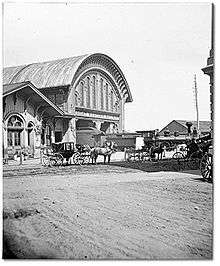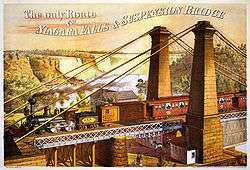Great Western Railway (Ontario)
| Locale | Southwestern Ontario, Niagara Peninsula |
|---|---|
| Dates of operation | 1853–1882 |
| Track gauge | 4 ft 8 1⁄2 in (1,435 mm) standard gauge |
| Previous gauge |
Built to 5 ft 6 in (1,676 mm) but converted by the 1870s |
| Headquarters | Hamilton, Ontario |

- This article is about a historic railway which operated in the British colony of Canada West, today known as Ontario. For other articles of the same name, see Great Western Railway (disambiguation).
The Great Western Railway was a historic Canadian railway that operated in Canada West, today's province of Ontario. It was the first railway chartered in the province, receiving its original charter as the London and Gore Railroad on 6 March 1834, before receiving its final name when it was rechartered in 1845.
Due to the length of construction, it was beaten into service by six months by the Ontario, Simcoe and Huron Railway, becoming the second operational railway in the province. Entrepreneur Samuel Zimmerman was instrumental in promoting its construction and Roswell Gardinier Benedict, a friend of Zimmerman's, was the assistant chief engineer and later the chief engineer.
Sir Allan MacNab was the driving force behind the financing of the railway in Canada (and less so in the United States and England), although he was pushed out of the company in 1854.[1]
The original line completed in 1853–54 connected Niagara Falls to Windsor, running by way of Hamilton and London. In 1855 two important additions were made: the opening of the branch to Toronto and rail connections over the newly opened Niagara Falls Suspension Bridge. Further branches were opened to Sarnia and communities in the Bruce Peninsula.
On March 12, 1857, the Desjardins Canal railway bridge in Hamilton collapsed. The Great Western Railway disaster claimed 59 lives.[2]
At its peak the Great Western system stretched 1,371 kilometres (852 mi) with its main operating base in Hamilton. The city at the Head-of-the-Lake was pivotal in opening up the unpopulated and heavily wooded interior of what was then known as Canada West. A substantial part of revenue was the railway's function as a bridge line between the New York Central and Michigan Central Railroads, making it significant in North American history.

The line was taken over by the Grand Trunk Railway in August 1882, and ultimately became a major part of Canadian National Railway's southern Ontario routes. The majority of the mainlines remain in use. The main Niagara Falls–Windsor line is now the Canadian National Railway's Grimsby Subdivision, Dundas Subdivision, Chatham Subdivision, and CASO Subdivision. The Toronto branch is the Oakville Subdivision, and the Sarnia branch is the Strathroy Subdivision (which also includes a short piece of the main line, from London to Komoka).
References
- ↑ Smith, Edward (2007). ""All My Politics Are Railroads"". Dundurn Castle: Sir Allan MacNab and his Hamilton Home. James Lorimer & Company Ltd. pp. 75–84. ISBN 978-1-55028-988-6.
- ↑ Smith, Edward (2007). ""All My Politics Are Railroads"". Dundurn Castle: Sir Allan MacNab and his Hamilton Home. James Lorimer & Company Ltd. p. 83. ISBN 978-1-55028-988-6.
External links
- Great Western Railway, from Niagara Rails
- Great Western Railway in the Canadian Encyclopedia
- Great Western Railway
- Timeline from St Thomas Public Library
| Wikimedia Commons has media related to Great Western Railway (Ontario). |